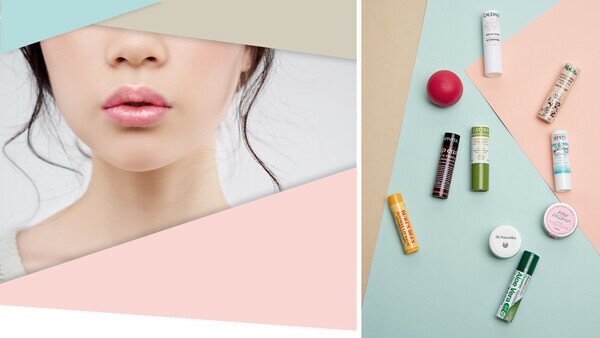As the cool dry weather sets in, lip balm with good moisturizing effect could make all the difference in soothing the parched lips. Increasingly a variety of lip balm products are promoting to contain no mineral oil ingredients to ease consumers’ concern over the risk of orally ingesting such substances. In a test on 10 mineral-oils free lip balms available in Hong Kong, the results showed the moisturizing effect of all products to be medium (2.5 – 3 out of 5 points) but, on the other hand, a wide variation existed in retail prices ranging from $39 to $160 per stick/pot, a difference of threefold. The product labeling in some cases was also inadequate. Only 2 stated clearly the expiry date and the period after opening. Consumers should therefore choose with care.
The test was undertaken by the International Consumer Research and Testing (ICRT) in coordination with consumer bodies from many countries on a wide range of popular lip balms available in the various markets. The results showed altogether 26 models contain no mineral oils. The overall rating of the 10 locally available models showed half of the models (5) were able to attain a score of 3.5 points out of a maximum of 5 while another half (5) slightly lower at 3 points.
Trial users taking part in the test applied the samples on their inside volar arms and assessed the skin hydration level after a period of 2 hours and 6 hours respectively. Upon completion of the 2 periods, 9 models were measured with a significantly increased skin hydration level, recording a medium moisturizing performance at a 3-point rating. The other 1 model though measured with medium moisturizing effect after 2 hours, its performance after 6 hours had no significant difference from the baseline and thus only scored a lower 2.5 points.
Trial users also assessed the samples based on their perception of product effectiveness and acceptance of the products such as the packaging, stickiness and greasiness after use, they then rated the test models with scores ranging from 3.5 to 4.5 points. The findings reflected a variation between the user trail assessment and the measured results. In 2 of the samples, the trial users perceived their moisturizing effect to be less satisfactory although the test showed all the 10 samples to be more or less similar within a short period (2 hours). Aside from skin hydrates performance, product packaging, aroma and taste might also affect the users’ evaluation.
Comprehensive product labelling in many cases was lacking. Though 9 models were labelled with the expiry date, only 2 carried both the expiry date and the period after opening. 1 model was found without even an expiry date; another was without any information on its Hong Kong supplier and means of contact. Further, 9 models were labelled in English only which does not meet the needs of consumers that are Chinese literal only.
Fragrances are a frequent cause of allergy. According to the products/ingredient list on each, 9 models were labelled with fragrance allergen/aroma ingredients, 4 contained 1 fragrance allergen while the other 3 from 3 to 6 and 10 fragrance allergens. Consumers allergic to certain fragrances should be careful.
Whether or not mineral oil substances adversely affect the human body remains inconclusive. Both the European Union and Mainland China permit the use of mineral oils in the ingredients of cosmetics products. But research in recent years have noted that lip balm could easily be ingested orally into the body; and mineral oils may contain mineral oil saturated hydrocarbons (MOSH) and mineral oil aromatic hydrocarbons (MOAH). The former could accumulate in several body tissues including adipose, lymph nodes, spleen and liver while some of the latter are suspected to be genotoxic and carcinogenic.
Although existing legislation does not prohibit the use of mineral oils in the manufacture of lip balms, manufacturers are called upon to reduce the MOSH and MOAH content to ensure their products have minimal impact on the health of consumers.
In the choice of lip balm, consumers can find out from the ingredient list that the product may have mineral oils substances if it contains: petroleum, paraffinum liquidum/mineral oil, paraffin, cera microcristallina/microcrystalline wax, ceresin/ozokerite, synthetic wax, polyethylene, polybutene, and polyisobutene, etc.
Regular users of lip balm, young babies and children should possibly avoid choosing lip care products with mineral oils. Parents should be wary that some lip balm may have added special aroma and taste that children may be tempted by its taste and lick their lips all too often or use the balm many times, thus increasing the amount of mineral oil substances that may be ingested orally.
In the purchase and use of lip balm, consumers can follow the following suggestions:
- Some of the products’ melting point may be a bit higher, do not use in great haste but apply several times more to allow enough balm to melt deep into the lip;
- If the problem of dry lips becomes more serious, use the balm liberally every day to keep its moisturizing effect longer;
- If you have developed lip infection or cold sores, cease using the lip balm stick to avoid infectious contagion repeatedly;
- If you stay outdoors for a prolonged period of time, choose lip balm with sunscreen protection.
The Consumer Council reserves all its right (including copyright) in respect of CHOICE magazine and Online CHOICE.



